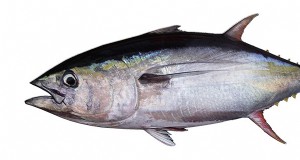生きている魚の輸送システム。生きている魚の輸送タンク。生きている魚の輸送タンクの熱隔離および酸素分配システム。
池 NS
本来は、 多くの魚は、他の動物や捕食者に食べられたり、病気や酸素不足で死んだりするため、成魚のサイズに達することはありません。池の養殖は、より多くの魚を生産するために状況を制御しようとします。池では、捕食者を制御して、池が自然の水よりも多くの魚を産むようにすることができます。池での魚の成長は、主に魚が逃げることができないという事実によるものです。 と給餌、 育種、 魚の成長と収穫は、よく計画された方法で行われます。
魚の養殖は池で行われています。これらは自然条件の小さな浅い水域であり、完全に排水可能です。 通常、人工的に建設されます。自然の池は、比較的大きな沿岸地帯と小さな深海地帯を持っているという点で湖とは異なります。それらの水源も異なる場合があります。
NS ist o NS y
池で魚を育てるのはとても古い習慣です。魚は紀元前2698年まで養殖されていました。中国で。文明が長期間定着したときはいつでも魚の養殖が起こっているようでした。魚の養殖は古代エジプトと中国で行われ、 4000年以上にわたって文明が続いています。池での魚の養殖に関する最初の記述は、ファンライによるものでした。 紀元前475年の中国の養殖業者古代ローマ人はアジアからギリシャとイタリアに鯉を紹介しました。 17世紀までに、 鯉の養殖はヨーロッパ中で行われていました。
W NS y fi NS NS gr o w 私 NS po NS NS NS
池での魚の養殖の実践はより有利です。天然資源から魚を捕まえるよりも、池から魚を捕まえる方が簡単です。魚の成長を制御することができます。魚は市場価値を向上させるために追加の餌を与えることができます。天敵が池の魚を殺さないようにすることができます。魚は病気から守ることができます。池では、 科学的管理法により魚の生産を増やすことができ、より多くの収入を生み出すことができます。養殖は、農民が土地を最大限に活用するのに役立ちます。魚の扇風機はまた、追加の収入を提供することができます。
NS y pe NS o NS fis NS 農場 NS
主に飼育の性質に基づいて、2つの主要な種類の養魚場があります。
1.稚魚や幼魚を飼育するために魚を飼育する養魚場。
2.稚魚または幼魚が市場に出せるサイズに育てられている養魚場。農民は、どのタイプの養魚場を始めるかを決める必要があります。
NS NS NS e NS o NS ワット e NS sup NS l y NS o ポン NS NS 、 NS NS e y ar e cla NS si NS NS NS 私 NS NS o 5 NS y pe NS 。
NS pri NS NS は て NS NS ond NS :湧水池は地下水から供給されており、 それらの底にある天然温泉を通して、またはそれらに隣接して横たわっている他のものを通して。湧き水はきれいで、不要な魚や魚卵が入っていないので養殖に適しています。スプリングが池に流れ込む前に長い距離をカバーしている場合は、 汚染物質が含まれている可能性があるため、使用する前にろ過する必要があります。
NS NS 私 NS は て NS NS o NS NS NS :これらはスカイポンドとも呼ばれます。これらは雨水で満たされ、それらの充満の程度は降雨量に依存します。
W e l l w NS て NS ポン NS NS : これらは井戸水で満たされ、魚の養殖に非常に適していると考えられています。それらは汚染物質を含まない水を適切に供給されるかもしれません。
NS l o o NS pl NS 私 NS 牛 – NS o w NS オン NS NS :これらの池の水は小川から供給されます。これらは、有機物の蓄積と定期的な洪水のために非常に生産的です。
W で e NS NS ou NS NS e NS オン NS NS : これらの池は流れる水の流れに配置され、さらに2つの主要なタイプに分けられます。
NS NS se NS o NS w NS NS e NS NS u ppl y 、 NS o 私 l NS NS NS NS o NS オグラ NS NS y NS NS e NS o NS NS ar e o fファイブ タイプ。
これらの池の建設の多くの側面は同じです。これらの主な違いは水源です。これらは :
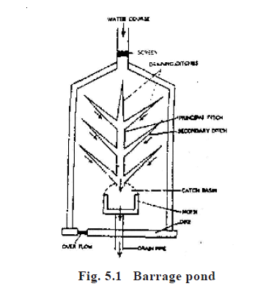
NS NS NS ra NS e NS オン NS NS : これらの池は通常、降雨または湧き水で満たされています。春、 例えば、 小さな谷や斜面を下って流れる水を低い場所に送ります。または、 春が地面から自然の窪みに泡立ちます。池は谷のふもとと低いところに水を集めることでできています。農民は、内部に水を保持する壁またはダムを建設することによってこれを行います。 今何、 池のエリアです。建設しなければならない池の壁の数は、土地と排水システムによって異なります。弾幕池は通常、水源と池エリアの間の主壁である壁を1つだけ必要とします。
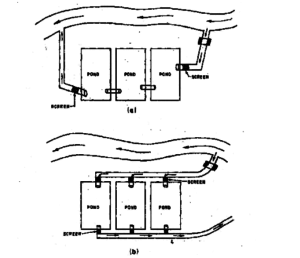
NS ivers 私 o NS 池 NS NS )。 Ro NS ar y システム NS NS )。 NS aralle l NS y ste NS
水門カートと呼ばれる一種の排水システムを使用して、池に水を出し入れします。複雑な構造を必要としない、使用できる簡単な排水システムもいくつかあります。
水の圧力が大きすぎると水が壁を壊さないようにすることが難しいため、水の流れが大きすぎる場所に弾幕池(図5.1)を建設しないでください。よく流れる小川や小川、 しかし、それほど強くはありません、 弾幕の池のための良い情報源を作ります。
水の流れが良くなくても、 しかし、 弾幕池にはオーバーフローチャネルが必要です。弾幕池は通常低地に建設されるため、 彼らは大雨の間にいっぱいになる可能性があります。オーバーフローチャネルは、池が過剰な水を集めるのを防ぐために設定できるあらゆる種類のシステムを構成します。オーバーフローは池から余分な水を奪います。この余分な水が排出されない場合は、 池の壁が壊れる可能性があります。
NS ive NS sio NS ポン NS NS :
これらの池は、小川や川などの別の水源から水を迂回させることによって作られています。水源から池に水を運ぶために水路が掘られています。迂回池はいくつかの方法で作ることができます。時々、池は平らな地面に掘られたり、土地の自然の窪みをわずかに拡大することによって作ることができます。これらの池は、土地の地形に応じて壁を必要とします、 排水システム、 NS。
迂回池(図6.2)では、 水は、池に直接流れ込むのではなく、常に分水路を通って池に運ばれます。水はさまざまな方法で迂回させることができます。近くの大きな小川から水を得る小さな小川を堰き止めて、池に水を供給するための分水路として使用することができます。迂回池は2つの方法で建設できます。
NS オサール y sy NS て NS :
これらの池は次々とひもで造られています。すべての池は互いに流れ込み、1つの池であるかのように管理する必要があります。入り江のあるシリーズの最初の池が、毒殺されなければならない捕食者でいっぱいの場合、 他のすべての池は、最初の池が毒される前に収穫され、排水されなければなりません。
NS aralle l システム :
各池には独自の入口と出口があります。したがって、 各池は別々の池として管理することができます。並列システムはより優れたシステムです。しかし、数珠システムはより安価で簡単に構築できます。水源が良ければ、 捕食者がいない状態を保つことができます。 池の管理がうまくできていれば、 これはより安価でより良いシステムです。
迂回池は常に弾幕池よりも優れています。これは、それらがオーバーフローする可能性が低く、水源が年間を通じてより信頼できるという事実によるものです。弾幕池、 しかし、 必要な建設が少なくて済み、安価になる可能性があります。
NS ond NS NS NS y al NS o NS e NS ラス NS ifie NS NS NS NS ordin NS NS o NS ei NS NS iz e NS NS u たるみ e の NS 魚 農場 の中へ 五 タイプ
これらは、魚の要件またはライフサイクルのその段階に従って構築されます。これらは:
NS ea NS po NS NS :この池は通常、多年生の水源の近くに建設されます。池の主な目的は、農場全体の水要件を満たすことです。 浸透による損失を考慮して、 蒸発など。
NS で NS やあ NS NS NS オン NS NS :これらは産卵池とも呼ばれます。これらは小さく、ほとんどが小さなタンクまたはプラスチックプールの形をしています。 スポーンコレクションセンターの近くで作られました。ハパはこれらの池に固定されています。卵は集められ、孵化のためにハパスに保管されます。同様の池が養魚場にも建設されています。これらは水循環で少し深くなります。ここでも、 ハパスは池の中に固定されています。ひなはホルモン注射をした後、ハパに放出されます。産卵はハパの内部で行われ、卵もここで孵化することができます。
NS urs e NS y NS ond NS :これらは移植池とも呼ばれます。これらは季節限定の池であり、産卵池と飼育池の近くに建設されます。主な目的は、餌の入手可能性と稚魚の成長の適切な条件を作り出すことです。なぜなら、この段階では、波の作用や捕食者などの危険に最も影響を受けやすいからです。これらは小さくて浅い池0.02〜0.06ヘクタールでなければなりません。サイズと1〜1.5メートル。深く。保育園では、 スポーン(5〜6 mm)は、約15日間フライステージ(25〜30 mm)まで飼育されます。これらの池は通常、長方形のサイズです。若いステージを育てるために特別な注意を払う必要があります、 そうしないと、重い死亡率が発生する可能性があります。スポーンは30日間培養されることもあります。池の底は、簡単な網の操作を容易にするために、出口に向かって緩やかに傾斜している必要があります。小規模で季節限定の苗床は、環境条件の効果的な管理に役立つため、好まれます。実際には、1ヘクタールあたり約1,000万の産卵が養殖池に蓄えられています。
NS 耳 私 NS NS po NS NS NS :これらは少し大きくする必要がありますが、比例して深くすることはできません。これらは苗床の近くに配置する必要があり、その数は文化によって異なる場合があります。それらは、サイズが0.08〜0.10 ha、深さが1.5〜2.0mであることが望ましい。稚魚(25-30 mm)は、ここで幼魚(100-150 mm)の段階まで約3-4ヶ月飼育されます。養殖池で育てられたコイの稚魚は比較的サイズが小さく、貯蔵池に直接移すには十分ではありません。貯水池には、稚魚を捕食する可能性のある大きな魚がいる可能性があります。したがって、 捕食に抵抗する能力が向上するように、適切な管理慣行の下で稚魚を幼魚のサイズまで飼育することが望ましい。
NS に ckin NS 池 :これらは最大の池であり、より深いです、 深さは約2〜2.5メートルです。池の大きさは0.2〜2.0ヘクタールの範囲で変動する可能性があります。 ただし、これらのサイズは0.4〜0.5haであることが望ましいです。これらは長方形の形をしています。幼魚とアドバンス幼魚は、約6か月間市場に出せるサイズまで飼育されます。 1歳の魚は1kgまで成長する可能性があります。重量以上。
ナーサー y po NS NS :
養殖池の管理は、魚の養殖を成功させるための最も重要な側面の1つです。孵化したばかりの子ガメやスポーンは、養殖池と呼ばれる小さな池で稚魚の段階まで飼育されます。子ガメ、 スポーンとフライは非常にデリケートですが、 これらは、 したがって、 非常に良い生存率を得るために細心の注意を払って飼育されます。
苗床管理は夏から始めなければなりません、 良い稚魚を育てることができるように。夏の苗床の乾燥は鉱化作用を助け、 有機デトリタスの除去と捕食者と水生雑草の破壊、 これは多年生の苗床にあります。池は脱塩する必要があります、 しかし、豊富な腐植土マトリックスを含む脱塩土の細かい層を使用して、苗床の池の側面や侵食された堤防を埋めることができます。これは、地球の豊かな表層の人為的価値を助け、池の生産性を高めます。アウトレット、 夏の間は、入り江と堤防の強化にも注意を払う必要があります。外灘の植生は昆虫の優れた繁殖地であり、 したがって、 これらは破壊されるべきであり、植生は夏の間に燃やされるべきです。
池の乾燥が不可能な場合は、 池の中毒に行ったほうがいいです。エンドリンのような毒、 タファドリン、 デリスの根の粉とモフアの油粕は、魚の敵を根絶するために使用されます。養殖池の管理を成功させるには、以下の飼育前後の管理手法に従う必要があります。
プレ – sto NS 親族 NS ポン NS NS アナ NS eme NS NS
それはサイトの選択を含みます、 雑草の根絶、 昆虫や捕食者、 石灰、 施肥、 NS。
NS NS e NS ma NS あなたは 私 NS NS 私 NS NS e NS オン NS :
土壌を豊かにするためには、池床での植物の成長が必要です。このプロセスは緑肥として知られています。エンドウ豆のような合法的な家族の短期作物、 豆、 などは、窒素による土壌の濃縮に役立ちます。植物の成長後、 池のベッドは耕され、土壌中の植物の根と同じ高さになります。これらの植物の根の根粒は、土壌を窒素で豊かにし、池の生産性を高めるのに役立ちます。 その結果、高い生存率と稚魚の急速な成長がもたらされます。
えー NS ディカ NS io NS o NS aq u ati NS 雑草 NS NS NS プレ NS エーター :
水生雑草は、水生昆虫の繁殖地を提供するなど、池に特定の問題を引き起こします。 捕食性の昆虫を収容することを可能にし、 稚魚の自由な動きを制限し、 網の間に閉塞を引き起こし、プランクトンの生産を枯渇させます。したがって、 雑草は、夏の間、機械的に、または化学薬品を適用することによって取り除く必要があります。
捕食者はスポーンを傷つけ、高い死亡率の原因となります。したがって、 捕食者は苗床から根絶されるべきです。略奪的な魚は チャンナ sp。、 ワラゴ アッツ、 ヘテロプネウステス 化石、 クラリアス batrachus、 アナバス キノボリウオ、 スポーンに最大の害を及ぼすなど、 そしてそれらを食物として使用します。のような雑草の魚 サルモストマ sp。、 Amblypharyngodon モラ、 バルブス sp。、 エソムス ダンリカス、 等は小型で不経済な魚であり、 コイのスポーンを捕食します。彼らは池で繁殖し、宇宙や食物で産卵するコイと競争します。
池の完全な排水は、望ましくない魚を根絶するための最良かつ最も簡単な方法です。ドラッグネットは釣りに繰り返し使用する必要があります。しかし、 捕食魚のほとんどは底生生物であるため、 ネットは問題を解決しないかもしれません。したがって、 魚の毒物はそれらを完全に根絶するために使用されます。 0.01 ppmのエンドリン、 0.01 ppmのディルドリン、 アルドリン0.2ppmおよびヌバン30ppmは、飼料魚および他のすべての魚の敵を根絶するのに役立ちます。これらの毒は1〜2か月間有効であり、繰り返し使用することはお勧めできません。毒は池の底に溜まり、後で取り除くことはできません。これらは、在庫の約60日前に処理する必要があります。
デリスの根の粉末(4 ppm)は、養殖池から飼料魚を根絶するのに適しており、1週間有効です。マフアオイルケーキ (マドフカ ラティフォリア) 250 ppmでは、魚を採餌するのに致命的です。仕入れる前に2週間適用する必要があります。飼料魚に致命的な影響を与えた後、 後で肥料として役立ちます。 1%濃度のサトウキビジャガリーも魚に致命的であり、その活性毒はサポニンです。ティーシードケーキは、600kg / haの割合で魚の種子に致命的です。 3〜5ppmの粉末シードカーネルの適用 クロトン ハズ、 の粉末根の2-6ppm ミレシア pachycarpa 、 の粉末シード20ppm バリントンニア accutangula 、 未熟粉末12ppm ランディア dumetorum と10ppmの粉末樹皮 ワルスラ ピシディア 効果もあります。
石灰 :
水のpHを維持するには、石灰が最も重要です。水は池の微生物を根絶するのに役立ち、また水の衛生状態を維持するのに役立つので、水はわずかにアルカリ性でなければなりません。石灰は、肥料中に生じる酸性条件を中和するのに役立ちます。石灰は250kg / haの割合で適用されます。酸性度の高い土壌では、その用量を1000 kg / haまで増やす必要があります。
W で エリ NS NS :
池に水をやりながら、 飼料魚が卵のどちらからも池に入らないように注意する必要があります。 若いまたは大人の段階。このため、 水は細かいふるいを通して入れる必要があります。保育園の池は1メートルの深さまで水で満たされなければなりません。
馬 NS あなたは 私 ng :
肥料は池に水を入れてから行う必要があります。肥料の主な目的は、適切な量のプランクトンを生産することです。 コイの種の自然食品として有用です。池の生産性を高めるために、いくつかの種類の肥料が利用できます。最も一般的な 、 すべての肥料の中で最も安価なのは生の牛糞(RCD)です。 10の割合で生の牛糞。 000 kg / haは、10日間で動物プランクトンの良い開花をもたらします。 5のアプリケーション 000 kg / haの家畜糞尿も、池でかなりの量のプランクトンを生成します。しかし、 3〜4日以内にプランクトンを生成する適切な肥料を見つけることをお勧めします。 5の混合物 000 kg / haの生の牛糞、 250 kg / haの単一の過リン酸石灰と250kg / haの落花生油粕(GNO)は、約3日でプランクトンを生成することがわかっています。この混合物を水に浸し、 よく混ぜて水面に広げ、 肥料が水に完全に混ざるように、 これにより、プランクトンの生産性が向上します。最初は約10日間、ストッキングに適用し、残りの7日間はストッキングに適用する必要があります。同じ養殖池から2つ以上の稚魚を生産する場合は、 その後、池は2で施肥する必要があります その後の各飼養の1週間前に000kg / haの牛糞。
無機肥料は、水の代わりに土壌を肥やすのに役立ちます。植物プランクトンの成長には、10:1の元素比のN:Pが必要です。無機肥料は通常、100〜150 kg / ha /年の割合で毎月10回に分けて施肥されます。
時代 NS icati NS NS ins e ct NS NS NS NS ot NS e NS NS NS rmfu l 生物相 :
昆虫は通常、一年の大部分にわたって池で大量に見られます。 特に雨の中と雨の後。これらの昆虫はスポーンを傷つけるので、根絶する必要があります。したがって、 産卵の最大の生存を確実にするために、昆虫は飼育する前に根絶されるべきです。ノトネクタ、 ラナトラ、 ゲンゴロウ、 Lethoceros、 ネパ、 HydrometraとBelostomaは、コイの種子を非常に破壊します。油エマルジョンを使用することにより、昆虫を根絶することができます。苗床を肥やした後、 それらはオイルエマルジョンで処理する必要があります。
油エマルジョンの噴霧は、昆虫を根絶するために、養殖池に産卵を蓄える前に12〜24時間です。 1ヘクタールの水を処理するには、60kgの油と20kgの石鹸を含む油エマルジョンで十分です。石鹸を最初に水に溶かし、それを油に加え、完全に攪拌して茶色がかった灰色の溶液を得る。その後、水面に広がります。水生昆虫はすべて、水面の油膜が薄いために窒息死します。昆虫の気門は油性の膜で閉じられて死んでしまいます。
56kgのマスタードオイルと560mlのTeepolのエマルジョンも、1ヘクタールの水を処理するのに役立ちます。エマルジョンは、ディーゼルボイラーオイルと任意の洗剤を使用して調製することもできます。石鹸は非常に高価になっているので、 効果的な方法の1つは、5リットルの水に50ccのHyoxyde-10を50リットルの高速ディーゼル油と混合して1ヘクタールの水に使用することです。
Herter W.P(0.6-1.0 ppm)と植物から抽出されたオイルの混合物 テリハボク テリハボク 昆虫だけでなくエビにも効果的です パレアモン ラメニ 私、 これは通常、保育園で見られます。ベンゼンヘキサクロリドの0.01ppmガンマ異性体とエチルアルコールの混合物も昆虫に対して非常に毒性があります。フマドールのような生分解性有機リン酸塩の応用、 Sumithion、 Baytex、 Dipterex、 など(0.25〜3 ppm)は昆虫を殺すのに役立ちます。
オイルエマルジョンが適用されるときはいつでも、 油膜を乱すので風があってはいけません、 そしてその有効性は根絶には感じられないでしょう。カワセミのような鳥、 サギや鵜は揚げ物や魚を破壊します。池を横切って伸びる細い線は、それらを制御する最も効果的な手段です。
NS NS オック 私 ng :
保育池での水の物理化学的性質とプランクトンの成長を満たした後、 スポーンは、500万から600万スポーン/ haの割合で池にストックすることができます。飼育は、スポーンが池の水に徐々に順応した後、早朝または深夜に行う必要があります。
NS ost- NS トック 私 NS NS ポン NS NS アナグ e 男性 NS
養殖池を用意した後、 最適な物理化学的特性とプランクトンを維持することをお勧めします。水の茶色は、動物プランクトンの豊かな成長を示しています。緑または青の色は、プランクトンの藻類が優勢であることを示しています。汚れた色は、水柱に沈泥が浮遊していることを示しています。養殖池では水深1メートルの維持で十分です。
化学的性質の中で、 3〜8 ppmの溶存酸素は、スポーンの貯蔵に適しています。 15〜20 ppmを超える二酸化炭素は、魚の生命に致命的です。 7.5から8.5の範囲のpHは非常に生産的です。 100〜125 ppmの総アルカリ度は、水中で非常に生産的です。 0.2〜0.4 ppmのリン酸塩はプランクトンの生産に適しており、0.06〜0.1ppmの硝酸塩は魚の成長に十分であると考えられています。養殖池の50リットルの水に1mlのプランクトンが産卵を蓄えるのに役立つと考えられています。
NS eedi NS NS :
仕入れ後、 1日か2日の間に、プランクトンのほとんどはスポーンによって消費されます。産卵の生存と成長は、池で利用できる餌の質と量に影響されます。スポーンの健全な成長を確実にするために、 人工給餌が必要であり、飼育後の翌日から回復します。長さ5〜6 mmの主要なコイの産卵は、0.0014mgの重さがあります。最も一般的に使用される人工飼料は落花生油粕です。 米ぬか、 ココナッツ、 マスタードケーキ、 微粉末でふるいにかけた落花生油粕と米ぬかを1:1で混ぜて使用します。給餌スケジュールは以下の通りです。
飼育後1-5日–スポーンの初期体重を2倍にします。飼育後6-10日–産卵の初期体重の3倍。
飼育後11〜15日–スポーンの初期体重の3〜4倍。
人工給餌のレベルは、物理化学的パラメーターとプランクトンの研究に基づいて、養魚業者が決定する必要があります。
NS NS rv e NS 私 ng :
保育園の15日間で、 スポーンは20-30mmサイズのフライに成長します。この段階では、 これらの稚魚は飼育池に移すことができます。補助給餌は収穫の前日に停止する必要があります。収穫は早朝に行う必要があります。同じ保育園の池で、 1シーズンに3〜4作物の稚魚を育てることができます。
NS e アリン NS ポン NS 管理 NS en NS
その管理は、貯蔵材料と貯蔵密度を除いて、貯蔵池の管理と同様です。このストッキング素材はフライステージですが、 約3ヶ月間、幼稚園まで飼育されています。稚魚の飼育密度は0.2〜30万/ haです。
NS NS ocki NS NS ポー NS NS 馬 NS アゲム e NS NS
養殖池で稚魚まで魚の種を飼育した後、 これらの幼魚は、飼育池で市場に出せるサイズに飼育されています。池の飼育と飼育の管理手法はほぼ同じです。
魚の最大量を得るには、最も経済的な管理措置を通じて最大限の注意を払う必要があります。養魚池の成功の多くは慎重な計画にかかっていることは明らかです。貯水池の合理的な管理の原則は、施肥と補助給餌によって池の環境収容力を増加させることです。 貯蔵操作による池の生態学的ニッチの最適利用、 水質の維持、 急成長する種の養殖と魚の健康状態の監視。
NS re-s NS オック 私 NS NS 男 NS 宝石 e NS NS
サイトの選択が含まれ、 池の調整、 池の水やりと施肥。
条件 私 tio NS の NS NS NS e NS ond :
池が魚を収穫した古い池である場合、 それは完全に耕されるべきです。耕作は池の底の乾燥に役立ちます、 鉱化作用を増加させ、 泥に溜まった不快なガスを取り除き、水生雑草や望ましくない生物を破壊します。池の底を耕すと土壌の状態が良くなり、 しかし、それは肥沃な最上層を埋めて、表面に無菌層を持ち出すほど深くてはいけません。生産性を維持するためには、池の乾燥が不可欠です。池の底には小枝がないようにする必要があります。 枝や切り株または死んだ魚。次に、底を再び滑らかにする必要があります。池が十分に乾いたら、 土には大きな亀裂があります。つまり、池の底の修復は、物理的な改善のために今最も重要であることを意味します。 土壌の化学的および生物学的状態。
短所 NS ro l o NS NS quati NS おしっこ NS NS :
水生雑草の成長は、池の土壌から栄養素を奪います。 魚の動きを制限し、 網の操作を妨害し、捕食性および雑草の魚や昆虫を収容します。したがって、 水生雑草は管理されるべきです。雑草防除の最良の方法は、池の乾燥と耕起です。
時代 NS ica NS io NS o NS u NS デシ NS abl e o rgan 私 SMS :
本当の問題は魚の飼育中に発生します、 他の動物が魚を食べるとき。カエル、 ヘビや鳥は若い魚を食べるので、池に近づけないでください。最悪の捕食者は肉食性の魚です、 水の入口をふるいにかけることにより、池に入るのを防ぐ必要があります。
池でよく見られる捕食性魚と雑草魚(図5.3)は チャンナ sp。 クラリウス batrachus、 ヘテロプネウステス 化石、 ワラゴ アッツ、 Notopterus notopterus、 ミストゥス sp。、 アンバシス ランガ、 Amblypharyngodon モラ、 サルモストマ sp。、 エソムス ダンリカス、 プンティウス sp。、 雑草は小型で不経済な魚で、通常は池で見られます。望ましくない魚が誤って池に入る、 鯉の産卵とともに入ってくる水を通して。捕食性の魚は、鯉の産卵期から成魚期までのすべての段階に有害であり、これらの鯉を捕食するだけでなく、餌や空間を求めて競争します。
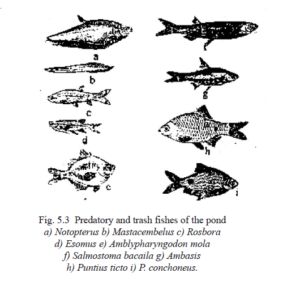
どんな池でも、 池に蓄える前に、すべてのゴミ魚と捕食者を取り除く必要があります。池を排水して乾燥させてから耕すという簡単な方法が、池を制御するのに最も効果的です。排水が不可能な場合は、 可能な限り完全に池、 望ましくない魚は、ドラッグネットを繰り返して池から取り除く必要があります。しかし、 多くの魚は池の端にとどまって網から逃げ出します。プラーチョンのような底の住人、 とまり木を登る、 magur、 シンギ、 NS。、 泥の中に潜り込んでいるものは、網で捕まえるのが難しい。脱水は最良の方法です、 ここで、水はポンプで除去する必要があります。 これは不経済な方法ですが。この場合、 望ましくない魚を取り除く最良の方法は、排水できない池の水を毒殺することです。
さまざまな種類の魚毒が市場に出回っています。これらは3つのグループに分類されます-塩素化炭化水素、 有機リン酸塩および植物誘導体。塩素化炭化水素は魚に最も毒性があります。これらは魚の組織に蓄積され、安定した化合物です。 代謝されません。有機リン酸塩は魚への毒性が少ないですが、 しかし、それらは水生動植物に悪影響を及ぼします。魚の組織では蓄積が少なく、水中での持続性は比較的低くなります。したがって、 植物の派生物は良い魚毒です。
最高の自然毒はマフアオイルケーキです、 デリスの根のロテノン、 生石灰(160 kg / ha)、 ティーシードケーキ(150 kg / ha)、 椿シードケーキ(水深により50〜200kg / ha)、 たばこ廃棄物(150-200 kg / ha)と綿の粉末種子(表6.1)。別の安全な化学物質はサポニンです、 これは茶の種のケーキの化合物であり、池に0.5ppmの用量で適用されます。自然毒のほとんどは、7〜12日で分解して水から消えます。マフア (マフカ ラティフォリア) 油粕は優れた毒です、 10日後に分解し、肥料として役立ちます。エンドリンのような化学物質、 ディルドリンとDDTは池では避けるべきです、 彼らは何年も地面にとどまり、後ですべての池の魚を殺すことができるので。
水生昆虫の根絶(図5.4)は、養殖池の管理で議論されています。
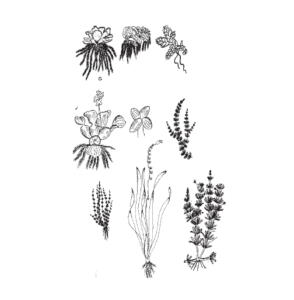
イチジク。 5.4 水生 昆虫
石灰 :
石灰は、水質を改善するために養殖業で頻繁に使用されます。池が耕された後、 クリアされ、スムーズになりました。 ライムでコンディショニングする必要があります。石灰は池の生産性を高め、衛生状態を改善します。それは予防的かつ治療的です。石灰の主な用途は次のとおりです。

イチジク。 5.5 水生 雑草
a)土壌と水の酸性度を帰化させます。
b)水中の炭酸塩と重炭酸塩の含有量を増やします。
c)過剰なMgの毒作用を打ち消します。 KおよびNaイオン。
d)バクテリアを殺します。 魚の寄生虫とその発生段階。
e)アルカリ予備力を蓄積し、その緩衝作用によってpHの変動を効果的に阻止します。
f)Fe化合物を中和します。 生物相を池に入れるのは望ましくありません。
g)無機化を促進することにより、池の土壌の質を改善する。
h)過剰な溶存有機物を沈殿させ、これにより酸素枯渇の可能性が減少します。
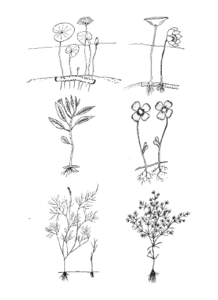
イチジク。 5.6 水生 雑草
NS) スイレン NS) ネルンバ NS) Jussiaea NS) マルセイユ e) ポタモゲトン NS) ナジャス
i)池の衛生状態を維持するための一般的な池の消毒剤として機能します。
j)石灰中のCaの存在は、有機物の組成を加速し、底質からCO2を放出します。
k)石灰はKを藻類に利用できないようにします。
新しい池は、水で満たされる前に石灰を塗ることができます。石灰岩は、乾いた池の底に均等に広がる必要があります。水がある池では、 水面に均等に広げる方が良いです。池が新しいか古いかにかかわらず、 石灰の層は池の底に置かれるべきです。水が池に汲み上げられる2週間前に、石灰を池に追加する必要があります。石灰施用に最適な時期は、施肥が停止している時期です。池に施肥している間は石灰を塗らないでください。
強酸性土壌(pH 4〜4.5)には、1000 kg / haの石灰が必要です。 一方、わずかに酸性の土壌(pH 5.5-6.5)には、約500 kg / haの石灰が必要です。ほぼ中性の土壌(6.5〜7.5 pH)は、200〜250 kg / haの石灰しか必要としません。最大限の効果を得るには、池の土壌のpHをほぼ中性にする必要があります。
W で エリ NS NS :
石灰が池の底に少なくとも2週間適用された後、 水はゆっくりと入れてください。水は水入口から池に落ちるはずです、 水が池に落ちるときに空気からの酸素と混合するように。水が池に早く入りすぎてはいけません。水があまりにも速く入る場合、 池の底がかき混ぜられて水が濁ります。スクリーンは入口で使用する必要があります、 不要な魚や他の生物が池に入らないようにします。池がいっぱいになった後、数日間は池を空ける必要があります。魚が池に放流される前に、池の水質をチェックする必要があります。
馬 NS あなたは 私 ng :
魚は成長して繁殖するために特定の要素を必要とします。これらの要素はC、 H2、 O2、 N2、 K、 NS、 NS、 CaとMg。他のいくつかの要素、 Cuのような微量元素と呼ばれる 亜鉛、 Mn、 Mo、 NS、 NS。、 少量でのみ必要です。これらの要素が欠落しているか、非常に少量存在する場合は、 魚はうまく育ちません。魚は池の土からこれらの要素を取得します、 池の水と彼らが食べる食べ物。一部の養魚池には、魚の成長と生産性に必要な要素が欠けています。これらの場合、 水に肥料を加える必要があります。肥料は不足している要素を含む単純な材料です。養魚池で最も頻繁に不足している、または不足している元素はN2、 PとK。これらの不足している要素からなる肥料は、魚とプランクトンの成長を助けるために養魚池に追加されます。 魚が餌として使うものです。
植物プランクトンが豊富な池は、明るい緑色であることがよくあります。色は藻類の異常発生を示します。通常の開花では、 透明度板は約30cmの深さで消えます。透明度板が深さ20〜40cmで消えると、 池は非常に生産的で肥沃です。これらの条件下では、池に肥料は必要ありません。
時々、池は肥沃になりすぎることがあります。透明度板がわずか15cmで消える場合、 花が厚すぎます。緑の厚い層は池の日光を遮り、植物プランクトンから酸素を放出することはできません。この場合、 池に肥料が多すぎて、 したがって、水面に形成された藻の厚い層の一部を除去する必要があります。これらの池は肥料を必要としません。
それでも透明度板が43cmの深さで見える場合は、 池のプランクトンは十分ではありません。です、 したがって、 肥沃な池を準備するために、池の水に肥料を加える必要があります。肥料の必要性を決定するもう一つの要因は、土壌の質です。土壌の生産性が高い場合、 肥料の必要性は少なくなります。土壌がそれほど生産的でない場合、 肥料の必要性はより大きくなります。
肥料の選択は、土壌の物理的組成に基づいて決定することができます。有機物の少ない砂質または砂質ローム質土壌では、 施肥は有機肥料で行われます。中程度の有機物を含むローム質土壌では、 a combination of both organic and inorganic fertilizer should be applied. In highly clay soil with rich organic matter, fertilization is carried out with only inorganic fertilizers. Amount of fertilizers to be applied to ponds may be worked out on the basis of the productive potentiality of the pond. The ponds can be categorised on the basis of N, NS、 organic carbon and alkalinity (Table 5.1).
In case of deficiency of potash, it can be included at the rate of 25-50 kg/ha/yr. The NP ratio should be 2:1.加えて、 cow dung may be applied at a rate of 10, 000-15, 000 kg/ha/yr. The best way to use this
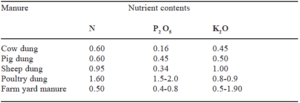
animal manure is to make a soup of it in a tank by mixing it with water. This soup should be spread in the pond. Fertilizer should be applied at a rate determined by the area of pond. Area is the length of the pond, multiplied by the width.例えば、 if a pond measures 20 m in length and 10 m in width, it has an area of 200 square metres (m2). This is equivalent to 2/100 of a hectare. To fertilize a 200 m2 fish pond with cow dung, at the rate of 1000 kg/ha, you must use only 20 kg.
Fertilization should be done 2 weeks prior to stocking the fish, となることによって、 sufficient natural food is available in the pond. 1/5 of the total quantity of organic manure is required as an initial dose, and the rest is applied in 10 equal instalments. Organic and inorganic fertilizers may preferably be applied alternating with each other in fortnightly instalments. The amount of fertilizers required in general for fish ponds is 10, 000 kg/ha/yr of cow dung, 250 kg/ha/yr of urea, 150 kg/ha/yr of single superphosphate and 40 kg/ha/yr of murate potash. In large ponds, fertilizers may be applied by using boats.
NS o ckin NS
Stocking is used to describe the act of placing the fish into the pond. The stocking density is used to describe the total number of fishes, which can be stocked in a pond. The stocking ponds are generally stocked with fingerlings which are about 75-100 mm in size. For increasing fish production, the selection of fish with desirable qualities is the most important biological factor. Since fish with the shortest food chain give the highest production, phytophagous, herbivores, omnivores and detritus feeders are preferred for culture in stocking ponds. For rearing of fish, either monoculture or polyculture in any species, combination may be carried out, most preferably the polyculture. The desirable stocking rate is 5, 000 fishes per hectare. In a monoculture pond, the stocking rate is the same as the stocking density because there is only one kind of fish. There is enough food and room in a pond for a particular number of fish. Good growth of fish depends upon the right number of fish cultured in the pond.
The stocking rate depends on the volume of the water and on the oxygen balance of the pond rather than the size of the pond. The ratio of fish to the volume of water should not be less than 1 fish to 2 m3 of water where there is no forced aeration.
As far as possible each pond should be stocked with silver carp and catla, the surface feeders. This should not be more than 30 to 35%, otherwise it would affect their growth adversely. Rohu is a column feeder and it should not be stocked more than 15-20%. Bottom feeders such as mrigal and common carp together can be stocked to the extent of 45%. Availability of aquatic weeds in the pond decides the stocking density of grass carp. It should preferably be about 5-10%.
Rearing of fingerlings to table-size fish may continue for one year or only 6 months. In the latter case, the stocking density may be reduced.このシステムでは、 harvesting is done monthly and the number and species of harvested fish are replenished with a new stock of fingerlings. This is possible only where the supply of fingerlings is available throughout the year. Under these conditions the production is much higher than with the annual or 6 monthly stocking and harvesting.
In a polyculture of Chinese carp, the stocking density is about 20, 000 fingerlings per hectare. The stocking rates are 5, 000 grass carp, 5、 000 bighead carp and 10, 000 silver carp. If common carp is also included, then in a stocking density of 7 Chinese carps, 2 fish would be grass carp, 3 would be common carp, and there would be only one each of bighead and silver carp.マレーシアで、 the ratio of carp stocking has been suggested at 2:1:1:3 for grass carp, bighead, silver carp and common carp.
If fishes are stocked in a pond, there should be enough oxygen, no temperature difference between the stocking water and the pond water. When the fingerlings are transported from a far away place, in order not to stress the fish, the bags with fingerlings are placed in the pond unopened until the water temperature inside the bags is about the same as the temperature in the pond. When it is same, the fingerlings are allowed to swim out of the container into the pond water by themselves. The fingerlings should not be poured into the pond water, as they die because of the shock of hitting the water.
位置 NS -stock 私 NS NS 管理 NS en NS
W NS て NS qua l それ y おとこ NS 宝石 e NS NS
Water quality managment is discussed in detailed
NS e e NS マナ NS eme NS NS
The feed management is discussed in detailed in chapter 6.
癒し NS NS 管理者 NS
The health managment is discussed in detailed in chapter 7
ハーブ e 臭い NS
The fishes are harvested after a one year with the help of gill nets. Five to Six fisherman depending up on the size of the pond enter into the pond from one side, move to wards the other end with gill net and catch the fishes.
Aquatic 雑草 と 彼らの コントロール
Aquatic vegetation is described as aquatic weeds. Any undesirable vegetation which causes direct or indirect damage to the fishes or hamper the fishery operations may be described as weeds. In the tropical regions of the world, aquatic weeds grow luxuriantly causing nuisence to fisheries, water transportation and water supply systems, and provide conducive habitat for factors of several diseases.インドで、 ponds and tanks usually have fertile soil and water and so they invariably overgrow with all types of aquatic vegetation. For successful farm management, a strict watch on the growth of unwanted vegetation is necessary. With the presence of excess vegetation it becomes very difficult to net fishes in weed infested ponds.
レア NS オン NS NS NS NS ont rol o NS 雑草 NS
Uncontrolled vegetation growing excessively hinder fisheries interest in many ways. The weeds in the water reduce the yield of fish just as the weeds in the field reduce the yield of cultivated crop. It is necessary to control the weeds in fish ponds. Some of the reasons for this are quite obvious.
1. Due to the presence of aquatic weeds in the pond, the fishes cannot swim properly, thus restricting their ability to browse and hunt for food.
2. Weeds absorb nutrients for their growth and multiplication, thus absorbing nutrients essential for planktonic food of fishes which causes depletion offish food. Due to their presence, water loses its fertility to sustain fish stock.
3. Weeds offer shelter to unwanted predatory and weed fish, which hunt upon or compete with the cultivated varieties.
4. By profuse growth, weeds choke the entire water column, restrict netting and make navigation impossible.
5. The presence of weeds in water reduces the water holding capacity of the area and water loss due to evaporation through leaves occurs. In case of few weeds, the evaporation is much more than that from the open surface.
6. Weeds cause wide dirunal fluctuation in dissolved oxygen, temperature and other physico-chemical parameters to make the water inhospitable for fishes.
7. The weeds accelerate the process of siltation of the water area, ultimately turning it into a swamp.
8. Weeds harbour harmful insects, カエル、 snakes and other predators enabling them to breed and multiply.
9. Weeds choke the gills of the tender young fishes.
10. The weeds interfere with the circulation and aeration of water, restrict the diffusion of sunlight and upset the normal chemical balance of the system.
11. The toxic gases in the pond bottom ooze produced by rotting organic matter cannot be easily eliminated into the atmosphere if the water surface is choked with weeds. In these conditions very few fish could survive in the water.
1 2 。 Aquatic weeds are responsible for minimising water depth and ultimately cutting down the soil-water interaction which is so essential for recycling of nutrients for the fishes.
13. Thick algal blooms deplete the oxygen in the water during dark hours or when they die or rot and cause sudden mortality of the fish stock.
14. Some kinds of algae cause allergic irritations on human skin and make it difficult for people to get into the pond.
15. The fish yield is reduced in weedy infested water bodies. 16. Weeds affect water irrigational potential.
NS dva NS タゲ NS o NS w e ed NS
Weeds do not always have harmful effects. The weed mass can be turned to some productive use which will recoup some of the losses involved in controlling them. The extra advantage of the utilization method lies in producing valuable end products. Different methods of control and utilization of weeds should be seen as useful tools in an integrated system of aquatic weed management. The aquatic weed are advantageous and help in the development and maintenance of a balanced aquatic community. The advantages are:
1. Aquatic weeds produce oxygen during photosynthesis and this oxygen is utilized by the fishes.
2. Weeds provide shelters for small fishes.
3. Weeds provide shade for fishes.
4. Weeds provide additional space for attachment as well as food for aquatic invertebrates which in turn serve as food for fishes.
5. Weeds help in the precipitation of colloidal clays and other suspended matters.
6. Weeds, after removal, can be used as bio-fertilizers and even used in fish farms.
7. Aquatic weeds are used as food for fishes like grass carp.
8. Weeds are also used for pollution abatement.
9. Weeds are used as a source of energy production.
W e e NS NS NS NS NS o NS NS NS NS は NS
There are a number of herbivorous fishes which directly consume aquatic weeds. The grass carp is a fast growing fish that feeds on aquatic weeds. The fish utilize submerged weeds like Hydrilla, Najas, Ceratophyllum, Ottelia, Nechamandra と Vallisnaria in that order of preference. The young fish prefer smaller floating plants like Wolffia. Lemna, アゾラ と Spirodela. In composite fish culture the production is greatly enhanced by inclusion of grass carp because of its fast growth. It also occupies an ecological niche, which otherwise remains unfilled with the fear that the grass carp may breed and compete with the native fish population in natural waters, only the triploid grass carp which is supported to sterile is being allowed to be introduced.
The other herbivorous fish which utilize aquatic weeds are Pulchelluspulchellus, Oreochromis と Etroplus. Though an omnivore, Cyprinus カルピオ feeds well on filamentous algae like Pithophora と Cladophora. The manatee, Trichechus sp., a large air-breathing herbivore, is being utilized for the clearance of aquatic weeds in the canals of Guyana.
These advantages of water plants become negligible when they are present in excess and their control then, 不可欠です。 The methods to be adopted to control the aquatic vegetation can be formulated only after the plants are identified.
NS NS ct o NS NS NS o ntr 私 bu NS の NS NS o NS rofuse NS ロウス
A number of factors either individually or jointly influence favourable growth of weeds in cultivable waters. These are :
1. Climatic condition and geographical situation of the area.
2. Water depth – lesser the depth, more is the growth of vegetation especially the submerged rooted or emergent vegetation.
3. Clarity of water or turbidity – more suspended material adds more turbidity thus retarding penetration of light in the pond which has an effect on the growth of vegetation.
4. Silt deposition at the bottom, promotes excessive growth of aquatic weeds.
5. Quality of water – fertile condition of water has its impact on the propagation of vegetation.
6. Infestation from other sources – the minute generative vegetative components like spores and cysts may be carried through the water supply, 風、 洪水、 鳥、 牛、 NS。
NS y pe NS o NS aq u で 私 NS おしっこ NS NS
The aquatic weeds (Fig. 5.5 and 5.6) are classified on the basis of habitat of plants – rooted weeds and floating weeds.
NS o ot e NS w ee NS NS
1. Bottom rooted weeds :Plants are rooted at the bottom of the water body and spread within the bottom layers of water. Vallisneria, Ottelia
2. Submerged rooted weeds :The plants are rooted in the bottom soil on the deeper margins of the pond and ramifying in the volume of water.例えば Hydrilla, Chara, Potamogeton
3. Marginal rooted weeds :Plants are rooted on the marginal region of the surface layer of water and ramify on the surface of water and also on the adjoining land.例えば Marsilia, Ipomoea, Jussiaea
4. Plants are marginally rooted and ramifying within the marginal region of the water volume.例えば。 Typha, Scirpus, Cyperus, Panium
5. Emergent rooted weeds :Surface plants which are rooted in the bottom of the pond but their leaves float on the water surface or rise above the water level. They prefer shallow parts and shores of the pond. NS。 Nymphea (Lotus), Nymphoides, Nelumbium 。
Flo NS 錫 NS 雑草 NS
1. Surface floating weeds :The plants are floating on the surface of water and with roots in the water.例えば Eichhornia (water hyacinth), Pistia, Lemma, アゾラ、 Spirodele 。 Few surface plants, are floating on water but without roots g. Wolffia 。
2. Submerged floating weeds :The plants are floating but submerged in the water e.g. Ceratophyllum, Utricularia 。
3. We can also divide the aquatic weeds broadly as floating, emergent, submerged, marginal weeds and algal blooms and filamentous algae.
覚醒剤 o NS NS o NS おしっこ NS co NS NS rol
Based on the intensity of infestation and type of weeds, the aquatic weeds can be controlled by means of manual, chemical and biological methods.
NS 。 NS NS u NS l NS NS NS 自分 NS ハン 私 ca l 自分 NS ホー NS
When infestation is scanty and scattered, the weeds can be controlled manually only in small water bodies. This is an ancient method and is still practiced in most of the places. The pre-monsoon period (April-May) is more suitable for manual removal. In many parts of the country, advantage is taken of the drought to control the weeds as ponds and other water bodies dry up or register a sharp fall in the water area, and the plants can thus be removed. Where labour is cheap, manual labour is often employed to remove aquatic weeds. The weeds are controlled manually by hand picking, uprooting the emergent and marginal weeds and cutting the others with scythes.
Most of the floating plants like Pistia, Lemna, アゾラ、 Wolfia と Eichhornia can be effectively controlled by clearing manually with nets, whereas, the marginal weeds like grass, sedges, 急いで、 Typha 、 etc. may be controlled by repeated cutting. This method does not inflict any pollution and there remains no residual toxic effect as in the case of chemical treatment or shading. The weeds thus collected should be dumped far away, be converted into compost manure or burnt so as to have no chance of reinfestation.
Manual weed control is very expensive, time consuming and unsatisfactory.したがって、 mechanical devices have been developed. Cleaning of a weed infested water sheet through the mechanical method, becomes necessary where the water area is not shallow enough to walk through or small enough to uproot the weeds manually or cut them effectively with simple hand implements. Labour problem and an urgency of the work to eradicate the whole area of weeds within a stipulated time period before water level is raised, are the other factors which make it necessary to resort to mechanical methods for eradication of weeds.
A number of devices ranging from very simple barbed wire bottom rakers to sophisticated mechanical equipments like power winches with steel wire, under-water cutter, dredgers, mechanised removers, etc. are in vogue to use for the purpose. Broomfork, long fork, sickels or scythes, long knives, barbed wire netting, chaining and motor powered weed cutters are some of the specialised equipment used for this purpose.
Crusher boats are used to clear water bodies infested with water hyacinth. The rooted submerged weeds are dislodged mechanically by dragging with log weeders fitted with spikes and barbed wires. Mechanical winches are used for cutting and dragging of submerged weeds.
Another simple method of control of water hyacinth is to construct floating barriers which prevent water hyacinth from reaching other water bodies. The floating barriers reduce time, labour and cost as the accumulated weed is removed by draglines.
Laser rays are also used to control water hyacinth, usually of 10.6 nm wavelength. The irradiated plants are plasmolysed immediately.
Burning follows in proportion with the amount of laser energy applied. Many of the plants die within ten weeks. Daughter plants are stunted and turned pale due to destruction of chlorophyll.
NS hemic NS l NS o ntrol :
A large number of chemical weedicides are used for control of aquatic weeds. It is a very effective and cheap method. The weedicide is to be selected in such a way that it should be cheap and easily available, non-toxic to fish and man, should not pollute the water and should not involve the use of special and costly equipment. The lethal action of the weedicide is either by direct contact or by translocation of chemicals from the treated part of the plant to the other areas of its system resulting in both cases in the death of the plant.
Different type of chemicals are in use for eradication of weeds. Many of these are poisonous, toxic or harmful for human and other animals. Their mode of action on the weeds are also different. The same chemicals may not be useful for the eradication of different types of weeds.
Chemicals used for eradication of weeds are broadly classified under three categories.
1. Compounds of heavy metals.例えばCopper sulphate, Sodium arsenate, NS。
2. Hormone weedicides g.2, 4-D, 2、 4、 5-T, NS。
3. Fertilizers. NS。 Superphosphate, 尿素、 Ammonia, NS。
According to the mode of action, a weed killer chemical can also be grouped into two categories.
1. Contact weedicides – which kill plants on contact.
2. Translocated weedicides – which are absorbed by plants and are killed.
The contact weedicides may be selective or non-selective killer types. The selective killer type of chemicals are effective only on some specific weeds whereas the non-selective type chemicals kill all types of weeds. Besides weedicides, some chemicals are used as soil sterilants. It shows that all chemicals are not suitable for killing all types of weeds and all the chemicals may not have all the qualities required for commercial use. Some chemicals are extremely poisonous for animals and human beings. Some chemicals like fertilizers are required to be applied at a very high dose which is neither economical not easy to apply. Endothal, Endothal amine salt, 2、 4-D are toxic to fish. Diquot is toxic to fish and not advocated to apply in muddy water.
ビオロ NS ica l 詐欺 NS rol :
Of all the weed controlling measures, biological control of weeds through stocking the water with weed-eating fish, such as grass carp, Ctenopharyngodon idella, is found to be an effective and satisfactory method. Grass carp is a voracious weed eater and possesses strong pharyngeal teeth, which enables it to grasp and nibble at soft weeds like Hydrilla. The nature of its gill rakers helps it to sieve large quantity of microvegetation from the water body. Because of its efficiency for weed consumption and convertibility into flesh it is preferred for stocking in weed infested waters.
Grass carp usually eat the soft parts of the aquatic plants leaving behind the harder parts like stem. It shows a certain preference for soft submerged weeds like Hydrilla 、 Ceratophyllum 、 Najas 、 Vallisneria 。 Its lower preference towards Ipomea is due to the hard nature of the weed. Hydrilla verticellata is the most preferred as it has soft leaves which could be easily nibbled and are easily digested.
Control of weeds, especially the soft submerged type of weeds, through biological control by stocking the water with grass carp has certain advantages. It is not only the most economical due to its low cost of operation and easy application but also does not contaminate the water with toxic substances unlike chemicals used for control.さらに、 it gives economical returns by increased fish production.
Common carp, Cyprinus カルピオ and Katti, Acrossocheilus hexagonalepsis and ducks are also used for biological control of aquatic weeds. Beatles and stemborers are also recommended for the purpose.
Biological control of weeds may be done by shading. Increasing turbidity, covering the surface by controllable floating weeds, shading the water area by canvas or coloured polythene sheets to cut down sunlight in order to check excessive growth and vegetation are some of the methods also in use.
Whichever method is used for the control of aquatic weeds, employment of manual labour is necessary. In the mechanical method labour is necessary for the clearance of the remains of the vegetative parts of the weeds. Even if the chemical method is resorted to, the dead weeds which sink to the bottom have to be removed. A rational utilization of all methods suitable according to the local condition and also economical is to be resorted to for eradication of weeds.しかし、 checking of excessive weed growth at the proper time is also one of the effective and important factors to keep the weed under control. Control measures should be adopted before the flowering season of the weeds. The time for control of weeds given below has been found to be appropriate under Indian conditions.
January-February March-May
June-July July-August
August-September October-November
– Eichhornia, lotus – Duck weeds
– Utricularia, Ottelia – Jussiacea, トラパ、
NS ymphoides 、 NS istia 、 Nechamendra
– Najas, Myriophyllum – Scrispus, Nymphaea
W NS て NS Quali NS y NS アナゲメ NS NS
Successful pond culture operations mainly depend on maintenance of a healthy aquatic environment and production of sufficient fish food organisms in ponds. Water is the primary requisite to support aquatic life. Physical, chemical and biological factors play an important role in governing the production of fish food organisms and fish production in the pond. Water not only plays an important role in the fish production, but also it helps in the survival and growth of the fish.したがって、 fish farmers should take a lot of care to maintain hygienic conditions in the pond, so that they get more profits. If the water quality is maintained with utmost care, the farmers need not spend much money for curing the diseases. If the water quality is maintained, the fishes also have a good taste. Water quality is influenced by physical, chemical and biological factors.
物理学 NS l 要素 NS
The physical condition of water is greatly influenced with depth, 温度、 turbidity, light and water colour.
W NS NS e NS 部門 NS
Pond depth has a vital bearing on the water quality. Depth determines the temperature, the circulation pattern of water and the extent of photosynthetic activity. In shallow ponds, sunlight penetration upto the pond bottom and facilitates an increase in the productivity. A depth of 1-2 metres is considered optimal for biological productivity of a pond. If the depth is very less, water gets overheated and thus has an adverse effect on the survival of the fish.
W NS て NS 臨時雇用者 e ラトゥール e
Temperature affects fish migration, reproduction and distribution. It depends on climate, sunlight and depth of the pond. Temperature varies vertically in the water body and also shows diurnal fluctuations. Fish posses well defined limits of temperature tolerance with the optimal being 20-32°C. Indian major carps can thrive well in the temperature range of 18-38°C. Wide fluctuations of water temperatures affect the survival of fish. In very low or very high temperatures, the fishes are strained, spend more energy and growth of the fish is affected. These temperatures also affect the chromatophores of prawns, and the prawns develop a red colour. If the temperature is maintained optimally, the red colour disappears. At low temperatures the food consumption offish and prawns decreases and gasses are produced at high temperatures.したがって、 water temperature maintenance is very essential to obtain high yields. Fish and prawns or their seed have to be acclimatized whenever they are transferred from one pond to the other.
NS u rbi NS それ y
Water turbidity is mainly due to suspended inorganic substances like clay, シルト、 phyto – and zooplankton and sand grains. Ponds with a clay bottom are likely to have high turbidity. Turbidity reduces sunlight penetration and photosynthesis and hence acts as a limiting factor. If the turbidity is due to more suspended particles, they absorb nutrients in their ionic form, making them unavailable for plankton production. High turbidity also reduces the dissolved oxygen in the pond water. Turbidity is measured with the secchi disc. If the secchi disc disappears at 30-50 cm. the water is productive in nature. If it is not visible at a depth less than 25 cm, a dissolved oxygen problem could anse during the night. If it is more than 50 cm, the plankton produced is less in the pond water. In less turbid waters, the aquatic weeds growth is more. In highly turbid waters, the sand grains accumulate in the gills of the fish and prawns, causing suffocation and excessive secretion of mucous. High turbidity can be reduced by adding lime and alum. If the water is more turbid, it should be stored in sedimentation tanks and then used for fish culture. If the turbidity is more due to phytoplankton, water m the pond should be changed. Fertilizers have no effect in high turbid waters, hence fertilization of the pond should be stopped.
L 私 gh NS
Availability of light energy to a fish pond greatly influences its productivity and photosynthesis. In shallow ponds, light penetrates to the bottom and is responsible for luxuriant growth of aquatic weeds. In high turbid waters, the light will not penetrate to the bottom.これによると、 the vegetation at the bottom will decay and produce harmful gasses, which affect the fish and prawn life.
W で e NS NS o ルー NS
Water gets its colour due to phytoplankton, 動物プランクトン、 sand particles, organic particles and metallic ions. Water used for fish or prawn culture should be clear, either colourless or light green or blue in colour. Water colour is golden or yellow brown if diatoms are more. This type of water is best for prawn culture. Brownish green, yellowish green and light green coloured waters are also good for prawn culture. Water becomes greenish in colour when phytoplankton is more, develops a brown colour due to zooplankton and mud colour due to more sand grains. Water with black, blackish green, dark brown, 赤、 yellow colours are not good for culture. These colours are due to the presence of more phytoplankton, bad pond bottom and acids in the water. The red colour of water is due to the presence of high levels of iron and death of phytoplankton (phytoerythrin released).
ケミカ l fac NS また NS
The chemical factors like pH, 溶存酸素、 alkalinity, hardness, phosphates and nitrates influence the productivity of the pond.
NS NS
pH is the hydrogen ion concentration, which ranges from 0-14. Water is slightly alkaline in condition, with the optimal range of 6.5-8. Less than 5 and more than 10 pH is lethal to fish and prawns. The pH of pond water undergoes a diurnal change, it is alkaline during the day time and slightly acidic just before day break. The fluctuations of pH are similar to dissolved oxygen. pH fluctuations are more in phytoplankton and weed infested waters and water with less hardness. No sudden pH fluctuations in brackish water and sea water occurs due to their buffering capacity.The difference in pH from morning to evening should not be more than 0.5. When pH increases, ammonia and nitrites become toxic, when it is reverse H, S becomes more toxic. pH below 6.5 and above 8.5 is responsible for reduction of growth and resistance of parasitic infection increases in acidic waters. Whenever pH falls, lime should be added to the pond water. When pH is high, lime should not be used. Urea should not be used to reduce pH. This is because NH3 becomes toxic at high pH. It is always better to add new water to maintain an optimal pH. Alum or aluminum sulphate can be used to reduce the pH and turbidity. Alum removes phenolphthalin alkalinity. 1 ppm alum reduces 1 ppm phenolphtahlin alkalinity.魚、 prawns and their seed should be acclimatized to new water whenever they are transferred from one pond to another.
ディ NS 解決 NS oxyge NS
Dissolved oxygen is one of the most important chemical parameters, which has a great influence on the survival and growth of fishes and prawns. The pond water gets oxygen mainly through interaction of atmospheric air on the surface water of the pond and by photosynthesis. It is produced only during daytime, reaches a maximum at 3 PM, then gradually decreases upto early morning. During the night it decreases and it reaches a minimum during the early hours. It is due to nil production of dissolved oxygen at night and instead, consumption of oxygen by plankton, 雑草、 fishes and prawns. During overcast days, the production of dissolved oxygen during the day is less and during the subsequent nights it decreases drastically.水温が上がると、 oxygen is released into atmosphere. When salinity increases it is dissolved in water. The optimum dissolved oxygen is 5-8 ppm. If less than 5 ppm the growth rate decreases the fish and prawns are prone to get diseases and less than Ippm of dissolved oxygen results in death. More than 15 ppm results in gas bubble disease in fishes and prawns. Whenever the animals are under stress due to less dissolved oxygen the food consumption temporarily decreases. When oxygen decreases, prawns accumulate on the water surface and near the pond shores and are found stationary at one place or show weak movements. Fishes come to the surface and engulf the air. Prawns get milky white spots when dissolved oxygen is continuously less. It decreases gradually from the surface to the pond bottom and CO, 、 NH3 and other gases increases, hence prawns are under more stress. Farmers should take precautionary measures at nights, especially during the early hours to increase oxygen levels. If it is very less, the water surface should be disturbed by beating water with bamboo poles or by rumming boats or by using aerators.
Alkalinit y
Alkalinity is caused by carbonates and bicarbonates or hydroxides of Ca, Mg、 ナ、 K、 NH4 and Fe. Alkalinity is less in acidic soils and in ponds with more organic load. Alkalinity is more in clay soil ponds and is increased if water is pot exchanged. The optimal level of total alkalinity is 40-150 ppm. Alkalinity has direct effect on the production of plankton. ‘
NS ar NS ne NS NS
Hardness is caused by Ca and Mg. Water with less than 40 ppm is soft and more than 40 ppm is hard water/ The pond water with a hardness of 15 ppm or more is satisfactory for growth of fishes and prawns and do not require additional lime. If water has less than 11 ppm hardness it requires liming for higher production. If it is less than 5 ppm, the growth rate is affected and causes eventual death of the fish.
NS アリン 私 NS y
ナ、 C12, Ca, Mg、 K、 bicarbonates and sulphates are responsible for salinity of the water. Salinity is an important parameter for survival, growth and high production in brackishwater culture systems. Salinity ranges between 0-40 ppt in brackishxvater and 35 ppt in sea water. The optimal salinity for prawn culture is 15-20 ppt. The prawns can survive at 2 ppt and 40 ppt. but their growth rate decreases. If the salinity is high, the water should be exchanged. Due to heavy rains more freshwater enters into the ponds and sudden decrease is found in salinity levels which affect the life in the pond.これを回避するには、 two outlets (one at high level and other at low level) should be provided to send out freshwater and sea water separately from the pond. The animals should be acclimatised before introducing them into new water.
Ca NS bo NS dio NS id e
CO、 is produced during respiration and consumed during photosynthesis. CO、 is less during daytime and more at nights. The optimal level of CO, is 5 ppm. At high CO, levels, pH decreases, CO、 is accumulated in the blood of the animals and water becomes acidic. The animals become sluggish, loss of resistance occurs, they cannot utilize dissolved oxygen and they ultimately die. Whenever CO, increases lime should be added to the pond. 1 ppm of lime reduces 0.9 ppm of CO, 。
ディ NS ソル v e NS うーん o ni NS NS NS 私 NS NS NS o mpo u NS NS
NH3 is found in excreta and is also released due to decomposition of organic matter. It is an important compound influencing the growth of phytoplankton in the aquatic ecosystem. The optimal limit of NH3 is 0.3-1.3 ppm and less than 0.1 ppm is unproductive. Whenever NH3 increases pH also increases, but dissolved oxygen decreases. CO2 reduces the toxic effect of NH3. NH3 also increases with feed due to high protein levels and death of phytoplankton. When NH3 is more in water, animals may not get excreta with NH3. NH、 accumulates in the blood and oxygen transport in the blood reduces. – Gills become black, biochemical tissue is damaged and gasous exchange is affected. NH3 levels can be reduced with good management like no excess feed, optimal stocking and water exchange. Lime should not be added when NH, は高い。 Optimal level of nitrites is 3.5 ppm.
Hydr o ge NS sulp NS id e
H2S is produced in anaerobic conditions by the action of-micro-organisms on sulphur compounds. NS、 S is toxic to fish and prawn. It should be less than 0.05 ppm in pond water. H2S is responsible for respiratory problems. When H, S increases, lime should be added.
NS 私 オロギ NS NS l 事実 o NS NS
The biological factors like plankton, weeds and disease causing agents also play a role in water quality maintenance.
プラン k トン – ウォート NS qu NS 点灯 y
Plankton are free living smaller plants and animals, which move along with the waves. Plankton are natural fish food organisms, which consists of 60% easily digestible proteins. Phytoplankton produce food and O, by photosynthesis. Plankton density variations depend upon the fertilizers used and fish species cultured. Carbon, 空気、 NS、 、 NS、 NS、 、 NS、 Fe、 K、 ナ、 Mn、 Mo、 亜鉛、 B and Cl, are essential for plankton production. Out of these, NS、 NS、 K、 are most important elements for plankton production.
To increase plankton production, organic and inorganic fertilizers should be used. Lime is also essential for plankton production. Fertilizers and lime should be used at regular intervals. This helps in production of plankton in sufficient quantities. Excess production of plankton, especially myxophyceae members settle on the water surface and form algal blooms. This hampers photosynthesis and oxygen depletion is observed, esp£Cially during nights. CO、 levels increase in the pond and affect water quality.
病気 NS e カウ NS の NS NS NS ent NS — ウォート NS 質 y
The most important aspect of water quality management in the culture system is to maintain fish without disease causing agents and under hygienic conditions. The diseases in fishes and prawns are caused by bacteria, ウイルス、 菌類、 protozoa, helminth, and crustacean parasites. These parasites enter into the pond along with water, fish or prawn seed and nets from other infected ponds. Due to the unhygienic conditions these parasites cause diseases in fish and prawns, and the fish and prawns become less resistant to diseases. Due to the parasitic infection the growth rate reduces and finally they die. To avoid these bad effects, use good and healthy material and fish and prawns should be examined once in 15 days. Abnormal behaviour offish and prawns is observed in infected ponds. These should be observed and immediate action should be taken, それ以外は、 whole crop could be wasted / destroyed.
アクア NS 私 NS w eed NS – w NS て NS 質 y
Excess growth of aquatic weeds in fish pond is not a good sign in aquaculture systems. Weeds utilize the nutrients and compete with desirable organisms. Weeds also compete for oxygen, especially during nights and space with fishes. They obstruct the netting operations too.したがって、 the weeds should be removed from ponds by mechanical, chemical or biological methods. Application of lime, fertilizers and feed are some of the important measures to maintain the water quality. These should be applied whenever required. Excess application leads to the poor condition of water quality.
笑 e o NS aer NS tor NS 私 NS NS e w NS て NS qu NS 点灯 y NS アナグ e 男性 NS
Atmospheric oxygen dissolves in the water at water surface. In this layer, dissolved oxygen increases quickly, but not at the pond bottom./To get oxygen even in the bottom layer, the pond water should be disturbed. To gedhis aerators are very essential. Aerators produce the air bubbles, which disturb the water in the pond, so that more oxygen dissolves in the water.Aerators, therefore play a vital role in aquaculture to increase fish and prawn production.
Different types of aerators are in operation to increase aeration in the ponds. Diffused, air lift pumps, U-tube and splashers are some of the common aerators (Fig 5.7) in operation in aquaculture.
In diffused type, the blower or compressor is arranged on the dyke, and this is connected to a porous tube, which is arranged on the pond bottom. Compressor produces air, which comes out of the porous tube in the form of air bubbles and disturbs the water to produce more dissolved oxygen. The capacity of the aerator depends upon the compressor energy and pond depth.
In air lift pump aerator, air is sent into a tube, which opens on surface of the water. Air bubbles travel through the tube and enhances the dissolved oxygen. This aerated water falls on water surface and increases dissolved oxygen water further.
In U-tube aerator, the U-tube has 12-18 metres depth.一方の端で。 air is pumped with the help of blower and the air bubbles travel to the other end i.e., air bubbles have more contact time with water. These aerators are more efficient, but need more expenditure for construction. Splasher type of aerators are also known as surface aerators. Propeller of the aerator is arranged near the water surface and water is sprinkled which helps in enhancing the oxygen in the pond. Paddle wheel surface aerators are also used in fish ponds. Sprinklers are used in fish ponds where porous pipes are arranged on the water surface and pump the air is pumped with engines into the pipes. This gives good aeration in the pond and produces successful results (such as those obtained in Kolleru area).
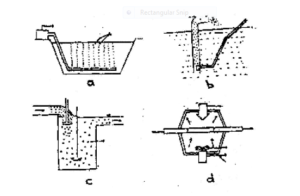
a) Diffused type b) Air lift type c) U-tube type d) Splasher type
笑 e o NS NS 私 lter NS 私 NS NS e ワット e NS qua l それ y NS NS ナグ e 男性 NS
Aquatic culture systems contain living organisms in water.These organisms require inputs, such as food and they excrete other materials. The inputs must be mixed with or dissolved in water to be available to the organisms, whose outputs will also become mixed with or dissolved in water. Excessive output and/or input can become toxic if the concentration is allowed to increase in the culture water. The process of removing excess materials is called filtration. It consists of passing the water through a thick layer of sand and gravel which act as strainers. Suspended and colloidal matter in the water and also a large number of bacteria are caught in the interstices of the sand during its passage. The mechanical, biological and airlift filters are generally adopted in aquaculture practices to manage and control the water quality for intensive rearing and culture.
メカ 私 ca l フィルト e NS
A mechanical filter (Fig 5.8 a) is an under drained water tight basin in which the filtering materials are placed. The size of a mechanical slow sand filter unit may be about 30 to 60 m x 15 to 30 m or more and about 2.5 m to 3.5 m deep according to desired flow. Water after passing through the filter is collected in an outlet chamber, which is equipped with a flow regulating arrangement. The filtering material about 90 cm to 150 cm of which about 60 cm to 90 cm is fine sand, is laid on top of the under drainage system in five or six layers in progressively smaller sizes towards the top.
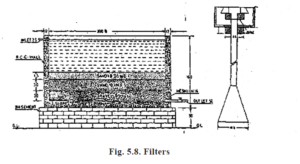
a) Mechanical filter b) Airlift filter.
The sand is supported on two or three layers of graded gravel, with the finest layer immediately below the sand and the coarsest material at the bottom of the filter, packed around the drains. The gravel layers must be graded sufficient to prevent the material from mixing and the sand being drawn down.
The following thickness may be taken for the filtering materials from the bottom towards the top.
1. 10 cm to 15 cm of broken stone 40 mm to 65 mm size
2. 8 cm to 15 cm of gravel 20 mm to 40 mm size
3. 5 cm to 10 cm of gravel 3 mm to 6 mm size
4. 15 cm of coarse sand and
5. 60 cm to 90 cm of fairly uniform fine sand.
When the resistance in the filter (due to sand and clogging) i.e., loss of head, is equal to the total depth of water on the filter, the operation will stop. The loss of head should not be greater than the depth of the filtering sand. When it becomes excessive and before a negative head is formed the filter should be cleaned. The level of the filtered water at the outlet chamber should not be below the level of the surface of the filter sand.
The rate of filtration is 120 litre per minute when the graded layers are 1′ sand of 0.05 to 0.1 mm, 6″ sand of 0.1 to 0.5 mm, 6″ gravel 2 to 5 mm and 1′ metal 5 to 10 mm at the total filtering surface area of 144 square feet.
Biologica l filte NS
It comprises the mineralisation of organic nitrogenous compounds, nitrification and dentrification by bacteria suspended in the water and attached to the gravel in the filter bed.
Heterotrophic and autotrophic bacteria are the major groups present in culture systems. Heterotrophic species utilize organic nitrogenous compounds excreted by the animals as energy sources and convert them into simple compounds, such as ammonia. The mineralisation of these organics is the first stage in biological filtration. It is accomplished in two steps; ammonification, which is the chemical breakdown of proteins and nucleic acids producing amino acids, and organic nitrogenous base and deamination in which a portion of organics and some of the products of ammonification are converted to inorganic compounds.
Once organics have been mineralised by heterotrophs, biological filtration shifts to the second stage which is nitrification, it is the biological oxidation of ammonia to nitrite and then to nitrate by autotrophic bacteria. Those organisms unlike heterotrophs require an inorganic substrate as energy source and utilise carbondioxide as their only source of carbon. Nitrosomonas と Nitrobacter sp. are the principal nitrifying bacteria in culture systems. Nitrosomonas oxidises ammonia to nitrite, Nitrobacter oxidises nitrite to nitrate.
The third and last stage in biological filtration is dentrification. This process is a biological reduction of nitrate to nitrite to either nitrous oxide or free nitrogen. Dentrification can apparently be carried out by both heterotrophic and autotrophic bacteria.
NS 私 NS l もしも NS フィルト e NS
It is the most trouble free means of filtering water through synthetic sponge layer by pumping the water with air lift (fig 5.8b). In culture applications, lift pipe extends below water level and the filter chamber rests above the top water surface. The suspended or colloidal impurities upto the size of 0.002 mm can be filtered out through this system. By pumping 5 cm3 air /sec/. 2 litres of water per minute can be filtered when the diameter of the lift pipe is 1 cm.
NS ええと NS ar y
Fish culture is practised in ponds. These are small shallow bodies of water in natural conditions and completely drainable, usually constructed artificially.The natural ponds differ from the lakes in having a relatively large littoral zone and a small profundal zone. Their source of water may also vary.
Nursery ponds are also called transplantation ponds. These are seasonal ponds and are constructed near the spawning and rearing ponds. The main object is to create a suitable condition of food availability and growth of fry because at this stage they are most susceptible to hazards like the wave action and predators. These should be small and shallow ponds 0.02-0.06 ha. in size and 1-1.5 m. in depth. In the nurseries, the spawn (5-6 mm) are reared to fry stage (25-30 mm) for about 15 days. These ponds are usually rectangular in size. Extra care should taken for rearing the young stages, otherwise heavy mortality may occur. Sometimes the spawn are cultured for 30 days also. The pond bottom should gently slope towards the outlet to facilitate easy netting operations. Small and seasonal nurseries are preferred as they help in effective control of the environmental conditions. In practice about 10 million spawn per hectare are stocked in nursery ponds.
Rearing ponds should be slightly larger but not proportionally deep. These should be located near the nursery pond and their number may vary depending upon culture. They should preferably be 0.08-0.10 ha in size and 1.5-2.0 m in depth. The fry (25-30 mm) are reared here upto the fingerling (100-150 mm) stage for about 3-4 months. Carp fry grown in nursery ponds are relatively small in size and not fit enough for their direct transfer into stocking ponds. In stocking ponds bigger fishes are likely to be present which may prey upon the fry.したがって、 it is desirable to grow the fry in rearing ponds under proper management practices upto fingerling size so that their ability to resist predation will be improved.
Stocking ponds are the largest ponds and are more deep, with a depth of about 2-2.5 m. The size of the pond may vary from 0.2-2.0 ha., but these should preferably be 0.4-0.5 ha in size. These are rectangular in shape. The fingerlings and advance fingerlings are reared upto marketable size for about 6 months. One year old fishes may grow upto 1 kg. or more in weight.
The pond management consists of pre-stocking, stocking and post stocking management phases.
Pre-stocking pond management involves site selection, eradication of weeds, insects and predators, liming, manuring, NS。
Post-stocking pond management involves water quality management, feed and health management and harvesting.
Based on the intensity of infestation and type of weeds, the aquatic weeds can be controlled by means of manual, chemical and biological methods.
生きている魚の輸送システム。生きている魚の輸送タンク。生きている魚の輸送タンクの熱隔離および酸素分配システム。
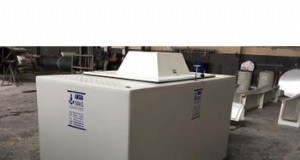
池の管理は養殖の重要な部分です。池の管理により、池には健康な動植物が確実に蓄えられます。 それはそれをきれいに保ち、それが成長するのを助けます。適切に管理された池はあなたのビジネスのためにより多くの魚を生産します!この記事では、池の管理の基本について説明します。 池のサイズを決める方法を含めて、 深さの要件、 事前在庫のヒント、 ポストストッキングのヒント、 そしてあなたがあなたの農場でどのような飼育密度を使うべきか。池は世界中の地域で見つけるのに人気のスポットです。池は飲むための水を提供します、 釣り、 そして灌漑さえ! 池は、端の近くを泳いでいる間、人々が作物を灌漑したり、網で魚を捕まえたりするために使用できる淡水を提供するため、どこに住んでいても生活の重要な部分です。これが、暑い夏の日に池が散歩に行くのに最適な場所になる理由です。片側を見下ろす木の枝の下には常に涼しい日陰があります 続いて、別の場所に日光が当たるだけでなく、日没時に泳ぐアヒルからのあらゆる種類の野生生物が続きます(これも彼らを素晴らしい家にします)。 淡水養殖の美しさは、ほとんどすべての種類の魚を池に放
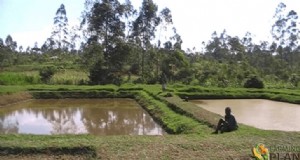
マグロの養殖: マグロの紹介 –肉用のマグロの養殖は、最近のビジネスとしてますます増加しています。 なぜなら、資本投入が少なく、最小限の手入れと管理でマグロ養殖の利益が増えるからです。 –マグロの養殖や肉用の魚の飼育は、非常に簡単な作業です。 しかし、高収量のマグロの品種を選ぶなど、いくつかの重要な作業には注意が必要です。 –商業目的の養殖は、マグロは重要な魚種の1つです。 これは国際市場で大きな市場の可能性を秘めています。 –マグロは、商業目的で養殖に使用される重要な魚種の1つである海洋生物です。 –この魚はマグロ族に属しており、サバ科(サバ科)のサブグループの1つです。この魚の部族は、世界中の他の魚よりも大きなサイズの16種の魚で構成されています。 –特に、いくつかの弾丸マグロ種は、サイズが最も小さく、重量が最大3kgです。 大西洋クロマグロ; 800kgまでの体重はマグロの残りの種の中で最大であり、約35年から40年以上生きることができます。 マグロの種 –ビンナガマグロ。 –ミナミマグロ。 –メバチマグロ。 –クロマグ
